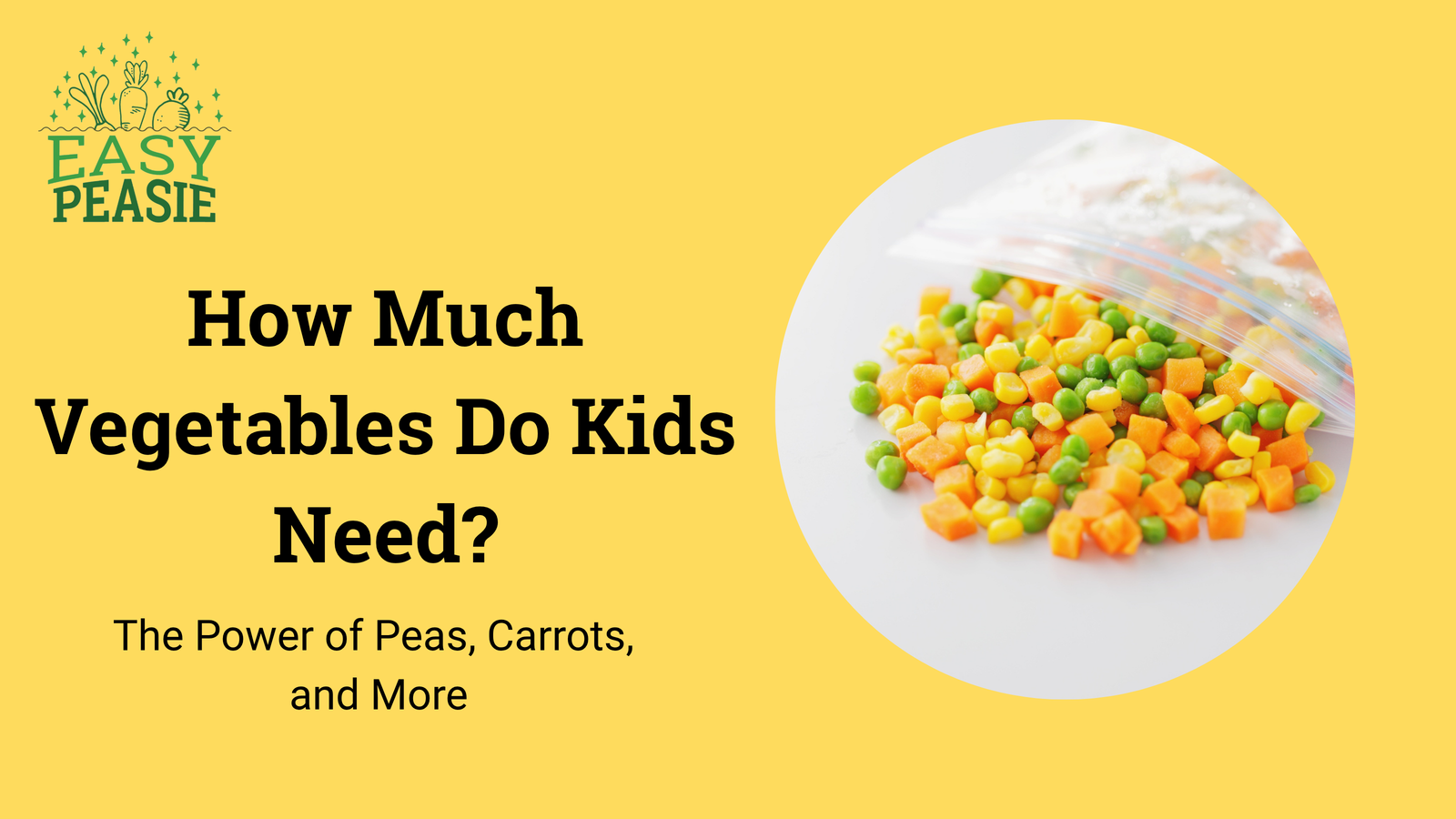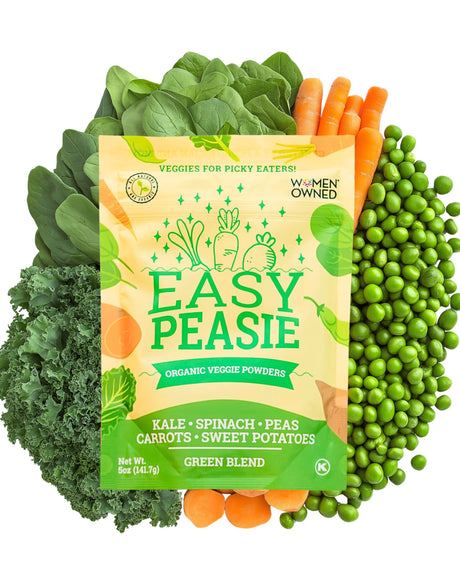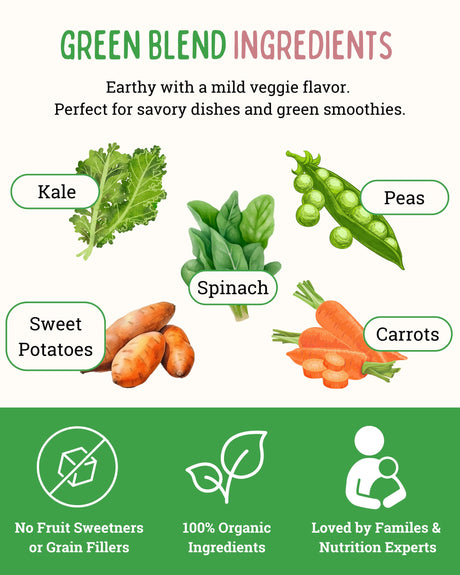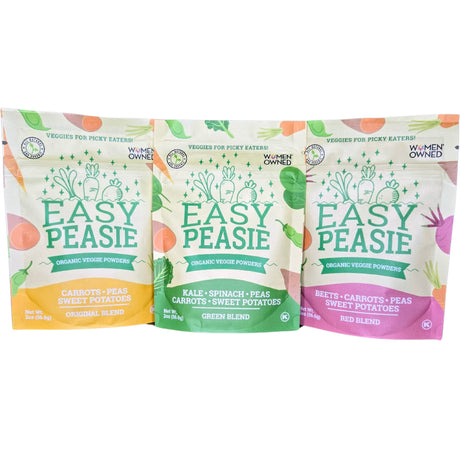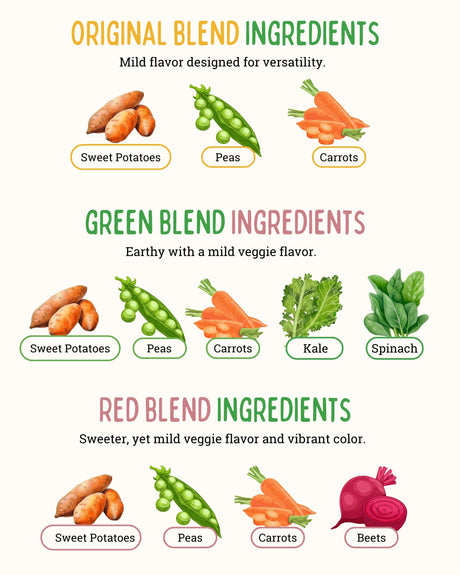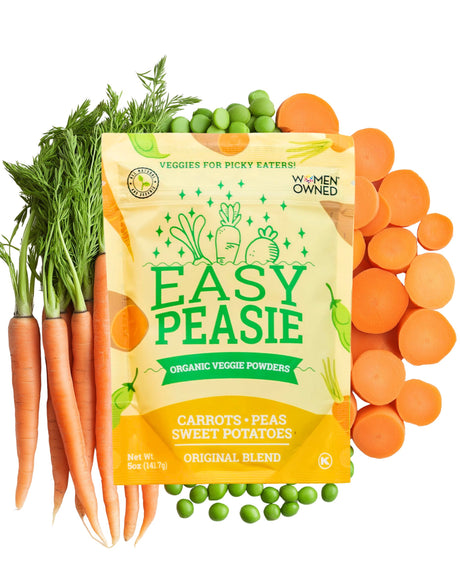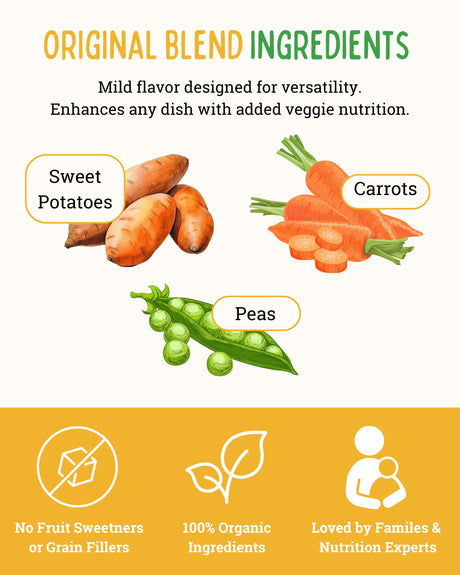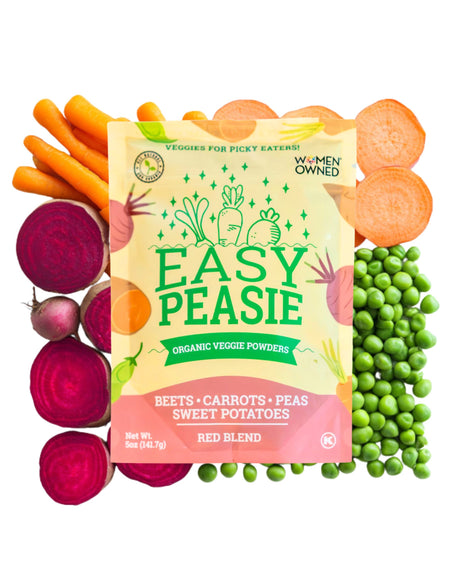You're standing in the produce section wondering if your child is getting enough vegetables, and more importantly, if the few vegetables they actually eat are providing meaningful nutrition. Between conflicting advice about servings sizes and the challenge of getting any vegetables into picky eaters, it's easy to feel overwhelmed about meeting your child's nutritional needs.
The truth is that vegetable requirements for children are more flexible than many parents realize, and some vegetables pack significantly more nutritional punch than others. Understanding both how much your child needs and which vegetables provide the most benefits can help you make strategic choices that maximize nutrition even when vegetable intake is limited.
Whether your child eats a wide variety of vegetables or sticks to just a few favorites, knowing the specific benefits of common vegetables like peas, carrots, sweet potatoes, kale, spinach, and beets can help you feel more confident about their nutrition while focusing your efforts where they'll have the most impact.
Understanding Vegetable Requirements by Age
The USDA dietary guidelines recommend that children ages 2-3 consume 1 cup of vegetables daily, children 4-8 need 1.5 cups, and children 9-13 require 2-2.5 cups depending on gender and activity level. However, these recommendations assume a varied diet and willing eaters - a reality that doesn't match many families' experiences.
What these guidelines don't account for is that vegetable needs can be met through concentrated sources, and that some vegetables provide significantly more nutrition per serving than others. A child who eats nutrient-dense vegetables in smaller quantities may actually be better nourished than one who eats larger amounts of less nutritious options.
What Counts as a Serving
Understanding serving sizes helps put requirements into perspective. For young children, a serving might be smaller than you think:
Typical serving sizes:
- Ages 2-3: 1/4 to 1/2 cup per serving
- Ages 4-8: 1/2 to 3/4 cup per serving
- Ages 9+: 3/4 to 1 cup per serving
This means that even small amounts of vegetables can contribute meaningfully to daily requirements, especially when those vegetables are particularly nutrient-dense.
Quality vs. Quantity
Rather than focusing solely on meeting specific cup measurements, consider the nutritional density of the vegetables your child does eat. A small serving of nutrient-packed vegetables like spinach or sweet potatoes provides more vitamins and minerals than larger servings of less nutritious options.
The Nutritional Powerhouses: Six Vegetables Every Child Should Eat
The vegetables we'll explore - peas, carrots, sweet potatoes, kale, spinach, and beets - are particularly valuable because they represent some of the most nutrient-dense options available.
Nutritional Comparison by Age Group (1/2 cup serving)
Peas (cooked)
| Nutrient | Amount | Ages 2-3 | Ages 4-8 | Ages 9+ |
|---|---|---|---|---|
| Protein | 4g | 13% DV | 8% DV | 7% DV |
| Fiber | 4g | 21% DV | 16% DV | 13% DV |
| Folate | 47 mcg | 31% DV | 24% DV | 12% DV |
| Vitamin K | 19 mcg | 25% DV | 16% DV | 13% DV |
| Iron | 1.2 mg | 17% DV | 15% DV | 10% DV |
| Vitamin A | 534 IU | 21% DV | 18% DV | 11% DV |
Carrots (raw)
| Nutrient | Amount | Ages 2-3 | Ages 4-8 | Ages 9+ |
|---|---|---|---|---|
| Vitamin A | 9,189 IU | 460% DV | 306% DV | 184% DV |
| Beta-carotene | 5,053 mcg | - | - | - |
| Fiber | 1.7g | 9% DV | 7% DV | 6% DV |
| Potassium | 177 mg | 6% DV | 5% DV | 4% DV |
| Vitamin K | 8 mcg | 11% DV | 7% DV | 5% DV |
| Vitamin C | 3.6 mg | 24% DV | 12% DV | 6% DV |
Sweet Potatoes (baked)
| Nutrient | Amount | Ages 2-3 | Ages 4-8 | Ages 9+ |
|---|---|---|---|---|
| Vitamin A | 16,408 IU | 820% DV | 547% DV | 328% DV |
| Beta-carotene | 9,444 mcg | - | - | - |
| Fiber | 3.9g | 20% DV | 16% DV | 13% DV |
| Potassium | 448 mg | 15% DV | 13% DV | 10% DV |
| Vitamin C | 22 mg | 147% DV | 73% DV | 37% DV |
| Manganese | 0.5 mg | 31% DV | 22% DV | 18% DV |
| Vitamin B6 | 0.2 mg | 20% DV | 12% DV | 10% DV |
Kale (chopped)
| Nutrient | Amount | Ages 2-3 | Ages 4-8 | Ages 9+ |
|---|---|---|---|---|
| Vitamin K | 53 mcg | 71% DV | 44% DV | 35% DV |
| Vitamin A | 5,376 IU | 269% DV | 179% DV | 108% DV |
| Vitamin C | 40 mg | 267% DV | 133% DV | 67% DV |
| Calcium | 47 mg | 6% DV | 6% DV | 4% DV |
| Iron | 0.6 mg | 9% DV | 7% DV | 5% DV |
| Folate | 9.6 mcg | 6% DV | 5% DV | 2% DV |
| Fiber | 1.3g | 7% DV | 5% DV | 4% DV |
Spinach (cooked)
| Nutrient | Amount | Ages 2-3 | Ages 4-8 | Ages 9+ |
|---|---|---|---|---|
| Iron | 3.2 mg | 46% DV | 40% DV | 27% DV |
| Folate | 131 mcg | 87% DV | 66% DV | 33% DV |
| Vitamin K | 444 mcg | 592% DV | 370% DV | 296% DV |
| Vitamin A | 9,433 IU | 472% DV | 314% DV | 189% DV |
| Magnesium | 78 mg | 39% DV | 25% DV | 20% DV |
| Vitamin C | 9 mg | 60% DV | 30% DV | 15% DV |
| Fiber | 2.2g | 12% DV | 9% DV | 7% DV |
Beets (cooked)
| Nutrient | Amount | Ages 2-3 | Ages 4-8 | Ages 9+ |
|---|---|---|---|---|
| Folate | 68 mcg | 45% DV | 34% DV | 17% DV |
| Fiber | 1.7g | 9% DV | 7% DV | 6% DV |
| Potassium | 259 mg | 9% DV | 7% DV | 6% DV |
| Vitamin C | 3 mg | 20% DV | 10% DV | 5% DV |
| Manganese | 0.3 mg | 19% DV | 13% DV | 11% DV |
| Iron | 0.7 mg | 10% DV | 9% DV | 6% DV |
DV = Daily Value. Percentages are approximate and based on standard nutritional guidelines.
Key Insights from the Nutritional Data
Looking at these numbers, several important patterns emerge that can guide your vegetable choices:
Vitamin A powerhouses: Sweet potatoes, carrots, and spinach provide exceptional vitamin A levels - often meeting or exceeding daily needs in a single serving. This is crucial for vision development, immune function, and cellular growth.
Iron champions: Spinach stands out as an exceptional iron source, providing 40% of daily needs for ages 4-8 in just half a cup. Peas also contribute meaningful iron, making these vegetables particularly valuable for preventing deficiency.
Folate leaders: Spinach and beets provide substantial folate, essential for brain development and cellular function. This B-vitamin is especially important during periods of rapid growth.
Age-appropriate impact: Younger children (ages 2-3) get higher percentages of their daily nutritional needs from the same serving sizes, making strategic vegetable choices even more impactful for toddlers and preschoolers.
Maximizing Nutrition When Vegetable Intake is Limited
Strategic Vegetable Selection
When your child will only eat a few vegetables, choosing the most nutrient-dense options maximizes the nutritional impact of their limited intake.
Prioritizing high-impact vegetables:
- Focus on the vegetables listed above for maximum nutrient density
- Choose colorful vegetables over pale ones for higher antioxidant levels
- Include at least one orange vegetable (carrots or sweet potatoes) for vitamin A
- Try to include one leafy green (spinach or kale) for folate and iron
Preparation Methods That Preserve Nutrition
How you prepare vegetables significantly affects their nutritional content and your child's acceptance. Understanding these changes helps you make informed decisions about cooking methods.
Raw vs. Cooked Vegetables: Raw vegetables generally retain the highest levels of water-soluble vitamins, which can be destroyed by heat or leach into cooking water. However, cooking isn't always nutritionally inferior - it can actually increase the bioavailability of certain nutrients.
Water-soluble vs. Fat-soluble vitamins:
- Water-soluble vitamins: Vitamin C and B vitamins (including folate, B6, and B12) dissolve in water and can be lost during cooking, especially when vegetables are boiled
- Fat-soluble vitamins: Vitamins A, D, E, and K are stored in fatty tissues and are generally more stable during cooking
Cooking effects on specific nutrients:
- Vitamin C (water-soluble): Easily lost in cooking water and destroyed by heat, so raw or quick-cooking methods preserve more
- Beta-carotene (converts to fat-soluble vitamin A): Cooking breaks down cell walls, making this nutrient more available for absorption
- Folate (water-soluble): Can be lost during cooking, so gentle cooking or raw consumption preserves more
- Iron: Cooking can improve absorption when paired with vitamin C-rich foods
- Fiber: Remains largely intact regardless of cooking method
Optimal cooking methods:
- Steaming: Preserves water-soluble vitamins better than boiling since nutrients don't leach into water
- Roasting: Concentrates flavors while making some nutrients like beta-carotene more bioavailable
- Quick sautéing: Brief cooking time with minimal water preserves most nutrients
- Microwaving: Can preserve nutrients well due to short cooking times and minimal water use
Dehydration and Nutrient Content: Dehydrating vegetables removes water while concentrating nutrients, but the process affects different vitamins and minerals differently:
Nutrient changes during dehydration:
- Concentration effect: Most minerals and some vitamins become more concentrated per gram as water is removed
- Water-soluble vitamins: Vitamin C and some B vitamins are reduced during the drying process
- Stable nutrients: Fat-soluble vitamin A, iron, potassium, and fiber remain largely intact
- Antioxidants: Many beneficial compounds are preserved and concentrated
Vegetable powders and nutrition: When vegetables are dehydrated and ground into powders, like those in Easy Peasie Veggie Powder Blends, the nutritional profile changes in predictable ways:
- Concentrated nutrition: Two tablespoons of vegetable powder can provide nutrients equivalent to a full cup of fresh vegetables
- Preserved minerals: Iron, potassium, and other minerals remain stable during processing
- Maintained fiber: Dietary fiber content is preserved in powdered form
- Some vitamin loss: Water-soluble vitamins may be reduced, but fat-soluble vitamins and many antioxidants remain
Practical implications: The best approach combines various preparation methods to maximize both nutrition and acceptance. Fresh vegetables provide optimal water-soluble vitamins like vitamin C, while cooked vegetables may offer better absorption of fat-soluble nutrients like vitamin A from beta-carotene. Dehydrated options like vegetable powders offer convenience and concentrated nutrition when fresh consumption is challenging.
Combining Vegetables for Enhanced Nutrition
Certain vegetable combinations enhance nutrient absorption and provide more complete nutrition.
Smart vegetable combinations:
- Pair vitamin C-rich vegetables (like sweet potatoes) with iron-rich ones (like spinach) to improve iron absorption
- Include healthy fats when serving fat-soluble vitamin-rich vegetables for better absorption
- Combine different colored vegetables to ensure a variety of antioxidants
Addressing Common Concerns About Vegetable Intake
When Your Child Won't Eat Vegetables
For families dealing with picky eating challenges, remember that even small amounts of nutrient-dense vegetables can be beneficial for your child's overall nutrition.
Strategies for picky eaters:
- Hide small amounts in accepted foods without changing familiar flavors
- Use vegetable powders to add nutrition without altering textures
- Focus on one vegetable at a time rather than overwhelming with variety
- Start with vegetables that have milder flavors or familiar textures
Products like Easy Peasie Veggie Powder Blends can provide concentrated nutrition from vegetables like peas, carrots, and sweet potatoes. Two tablespoons provide nutrients equivalent to a full cup of vegetables, helping ensure adequate intake even when whole vegetable consumption is challenging.
Balancing Variety with Acceptance
While variety is ideal, consistent intake of even a few nutrient-dense vegetables is better than sporadic consumption of many different ones.
Building on accepted vegetables:
- If your child eats carrots, try sweet potatoes for similar nutrition and taste
- Expand gradually from accepted vegetables to similar options
- Don't abandon vegetables your child accepts in pursuit of variety
- Use accepted vegetables as vehicles for introducing new ones
Seasonal and Practical Considerations
Vegetable nutrition and acceptance can vary based on practical factors.
Optimizing vegetable choices:
- Fresh, seasonal vegetables often have peak nutrition and flavor
- Frozen vegetables can be more convenient and equally nutritious
- Canned vegetables (low sodium) can provide good nutrition when fresh isn't available
- Consider your family's schedule and preparation capabilities
Meeting Nutritional Goals with Real-Life Constraints
Creating Realistic Expectations
Rather than striving for perfect vegetable consumption, focus on consistent, small improvements that can be sustained over time.
Realistic goal-setting:
- Aim for one serving of nutrient-dense vegetables daily rather than meeting exact cup requirements
- Celebrate acceptance of new vegetables even if consumption is minimal
- Focus on nutrients obtained rather than servings consumed
- Consider long-term patterns rather than daily perfection
Building Positive Relationships with Vegetables
How vegetables are introduced and presented affects long-term acceptance more than immediate consumption.
Positive approaches:
- Avoid pressure or battles over vegetable consumption
- Model enthusiasm for vegetables without forcing participation
- Include children in vegetable selection and preparation when possible
- Focus on exposure and familiarity rather than consumption
Working with Healthcare Providers
If you're concerned about your child's vegetable intake or overall nutrition, discuss specific concerns with your pediatrician.
When to seek guidance:
- Your child eats fewer than 5-10 total foods
- You notice signs of potential nutritional deficiencies
- Growth or development seems affected by limited diet
- Family stress around eating is high
Practical Implementation Strategies
Weekly Planning Approach
Rather than daily pressure, consider weekly vegetable intake patterns.
Weekly planning benefits:
- Reduces daily mealtime stress
- Allows for natural appetite variations
- Provides flexibility for family schedule changes
- Focuses on overall nutritional patterns
Age-Appropriate Implementation
Toddlers (2-3 years): Offer very small portions to avoid overwhelm, allow exploration and messiness, and pair vegetables with familiar, accepted foods.
Preschoolers (4-5 years): Involve in simple food preparation, use creative presentations, continue offering variety without pressure, and build on established preferences.
School-age (6+ years): Educate about nutrition in age-appropriate ways, encourage trying vegetables in different preparations, respect developing taste preferences while encouraging openness, and include in family meal planning decisions.
Long-Term Perspective on Vegetable Consumption
Building Lifelong Habits
The goal isn't perfect childhood vegetable consumption but building positive relationships with nutritious foods that last into adulthood.
Long-term success factors:
- Consistent, pressure-free exposure to vegetables
- Positive family attitudes toward healthy eating
- Understanding that taste preferences develop over time
- Focus on overall health rather than specific food rules
Adapting Strategies Over Time
What works for your child may change as they grow and develop new preferences and capabilities.
Staying flexible:
- Regularly reassess what vegetables your child accepts
- Try previously rejected vegetables again after several months
- Adapt preparation methods to changing preferences
- Continue offering variety even if acceptance is limited
The most important factor in meeting your child's vegetable needs isn't achieving perfect daily consumption but ensuring consistent access to nutrient-dense options and maintaining positive attitudes toward healthy eating. Focus on the vegetables that provide the most nutrition - peas, carrots, sweet potatoes, kale, spinach, and beets - and find ways to incorporate them that work for your family's unique situation.
Remember that even small amounts of these nutritional powerhouses can make a significant impact on your child's overall health. Whether through creative preparation, gradual introduction, or nutritional supplementation when needed, you can support your child's vegetable intake while building positive, sustainable eating patterns for the future.
This article is for educational purposes only and does not constitute medical advice. Always consult with your child's healthcare provider for concerns about nutrition, growth, or development.

